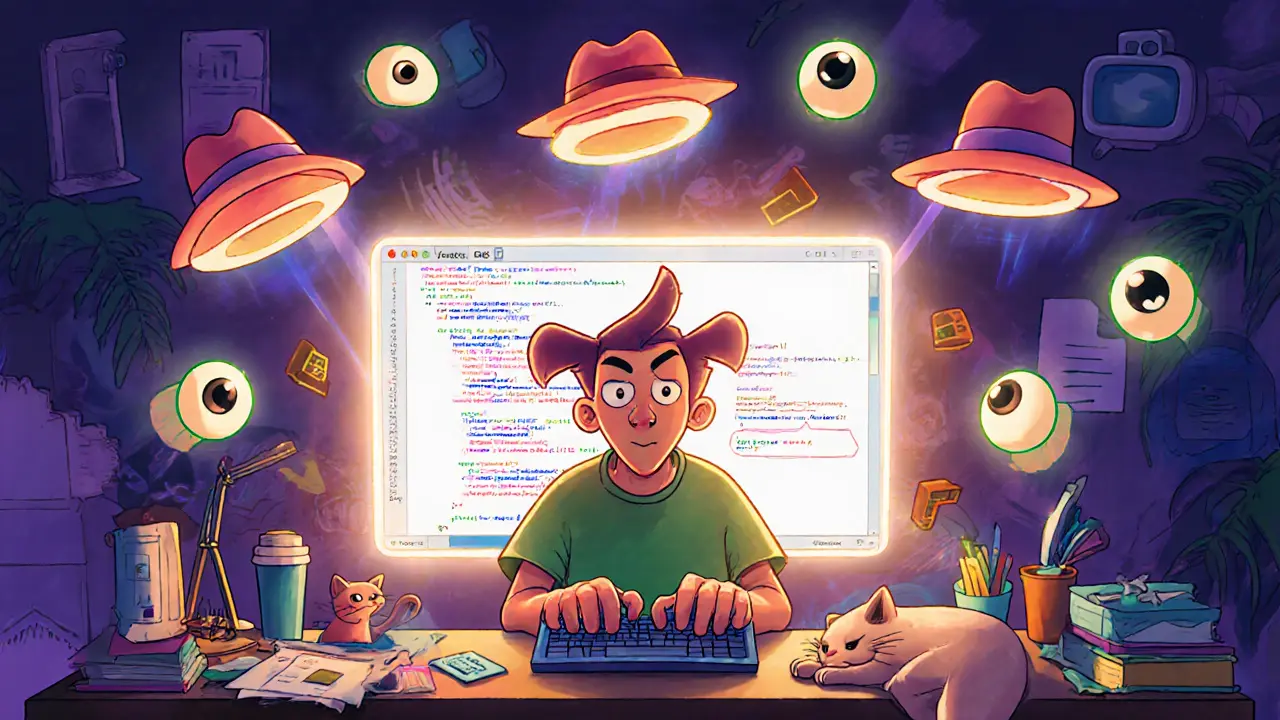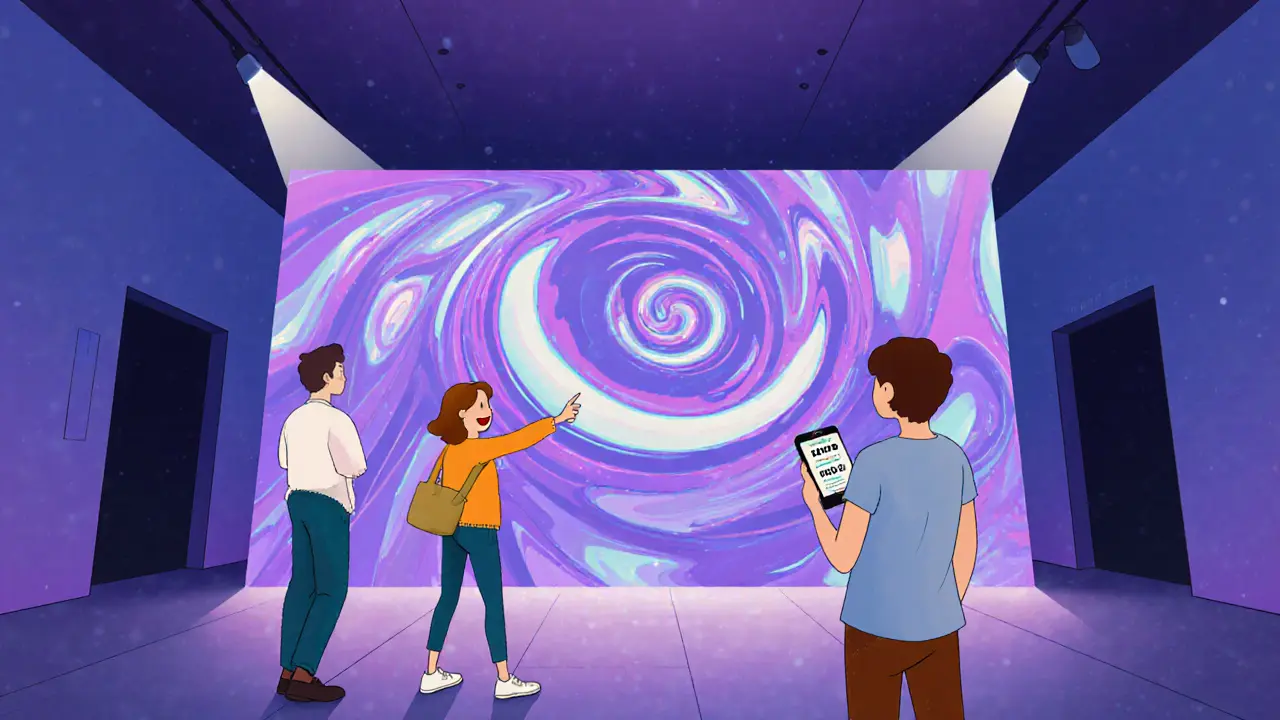Generative Art NFT Rarity Calculator
How Rarity Works
Generative art NFTs use multiple traits (backgrounds, accessories, etc.) with different rarity percentages. To calculate a specific combination's rarity, multiply each trait's percentage. Example: 0.7% crown + 1.2% silver wings = 0.7% × 1.2% = 0.0084% rarity.
Input Traits
Enter trait percentage as decimal (e.g. 0.7% = 0.7)
Enter trait percentage as decimal (e.g. 0.7% = 0.7)
Result
Enter trait percentages to see rarity calculation
Imagine buying a digital artwork without knowing exactly what it looks like until after you pay. You click mint, the blockchain spins, and suddenly-there it is. A swirling gradient of color, a lone figure in a neon field, a dog wearing sunglasses and red sandals. You didn’t choose it. The code did. And that’s the whole point.
What Exactly Is Generative Art NFT?
Generative art NFTs are digital artworks created by algorithms, not by hand. An artist writes code that sets rules-colors, shapes, layers, probabilities-and then lets the computer generate thousands of unique variations. Each one becomes an NFT, meaning it’s stored on the blockchain as a one-of-a-kind digital asset you own.
This isn’t just random noise. It’s controlled randomness. Think of it like baking a cake with a recipe that says: "Use vanilla, but randomly pick one of five frostings, and add sprinkles with a 2% chance." The artist controls the ingredients, but not the exact outcome. That’s what makes it generative.
The first major wave of this happened in 2020 with Art Blocks a platform that runs generative art algorithms on-chain, creating each piece at the moment of purchase. Before that, most NFT art was static-pre-rendered images like CryptoPunks. Art Blocks changed that. Now, when you buy a piece, the artwork is generated live on the Ethereum blockchain. No one-not even the artist-knows what you’ll get until it’s created.
How It’s Made: Code, Layers, and Rarity
Creating a generative art NFT collection starts with design layers. Artists build dozens, sometimes hundreds, of visual elements-eyes, hats, backgrounds, accessories-each saved as a transparent PNG. These layers are stacked on top of each other in code.
For example, in a 10,000-piece collection, a designer might set:
- Blue background: 60% chance
- Red background: 30% chance
- Gold background: 9% chance
- Neon rainbow background: 1% chance
Then they do the same for every other trait: hair, clothing, accessories. The rarer the trait, the lower the percentage. That’s how you get a piece with a glowing crown and silver wings-only 0.3% of the collection has it.
Artists use tools like p5.js a JavaScript library designed for creative coding, widely used in generative art NFT creation, openFrameworks a C++ toolkit for algorithmic art and interactive installations, or Canvas-sketch a Node.js framework for generating vector art with JavaScript. Some even use AI tools like DALL·E or Midjourney to generate base textures.
Platforms like fxhash a decentralized generative art platform built on Tezos, offering a no-code interface for artists let you upload layers and set rarity percentages without writing a single line of code. But if you want full control-like making the shapes shift based on the block number-you need to code it yourself.

On-Chain vs. Off-Chain: The Real Difference
Not all "generative" NFTs are created equal. CryptoPunks are often called generative, but they’re not. All 10,000 were rendered offline before being tokenized. You knew what you were getting before you bought.
True generative art NFTs happen on-chain. That means the code runs when you mint. The image is built from scratch in your wallet. This is harder. It takes more gas. Art Blocks projects often cost 15-25% more in transaction fees than regular NFT mints because the blockchain is doing heavy lifting.
But here’s the trade-off: on-chain generation means the artwork is truly immutable and verifiable. The code, the randomness, the final image-all stored on Ethereum. No server can go down. No artist can change it later. That’s why collectors pay premiums for on-chain pieces.
Why People Love (and Hate) It
For collectors, generative art NFTs feel like opening a mystery box. You don’t know if you’ll get the rarest version-or a "dud." Reddit user CryptoCollector42 minted Chromie Squiggle #3452 for 1.2 ETH and said: "It turned out with perfect gradients-I felt like I won the lottery."
But not everyone wins. A Trustpilot review from September 2023 reads: "I spent 0.5 ETH on a piece that was mostly black with one tiny shape. Felt like a ripoff."
Market data backs this up. According to CryptoSlam a leading NFT analytics platform tracking sales and trading volume across blockchains, 32% of generative art NFTs from lesser-known projects trade below their mint price. The top projects-like Tyler Hobbs’ Fidenza a generative art NFT collection by Tyler Hobbs, sold for over $3 million in 2021 and acquired by MoMA in 2022-still sell for 4-5 ETH. But most don’t.
Expert artist Tyler Hobbs says success comes from "deep artistic vision guiding the algorithm, not just random combinations." That’s the key. Randomness without intent looks like noise. Great generative art feels intentional-even when it’s unpredictable.

Who’s Buying This Stuff?
Generative art NFT collectors are mostly men (78%) between 25 and 44. Over 40% have tech backgrounds. They’re not just speculators-they’re enthusiasts who care about code, design, and the idea of machine-assisted creativity.
Art institutions are taking notice. In September 2022, the Museum of Modern Art (MoMA) a leading modern art museum in New York that acquired its first generative art NFT in 2022 added Fidenza #813 to its permanent collection. Sotheby’s held its first generative art auction in May 2022, netting $24.4 million.
Even the environment is improving. Ethereum’s switch to proof-of-stake in 2022 cut energy use by 99.95%. Generative art NFTs are no longer the climate villains they once were.
Where It’s Headed
Generative art is maturing. Art Blocks launched Editions in 2023-limited runs with physical prints tied to digital originals. fxhash is gaining ground in Europe, especially on the eco-friendly Tezos blockchain. And 65% of new projects now use AI to generate textures or styles.
Some artists are even making "dynamic" generative art-pieces that change based on weather, stock prices, or Twitter trends. Imagine a painting that shifts color when the New Zealand dollar rises. That’s not sci-fi anymore.
Still, the biggest challenge remains: balancing automation with artistry. Too much randomness, and it’s forgettable. Too little, and it’s just a static image with a blockchain label.
Generative art NFTs aren’t just a trend. They’re a new medium. Like photography in the 1800s, it’s messy, controversial, and still finding its voice. But it’s here to stay.
Are generative art NFTs just random images?
No. They’re controlled randomness. Artists design systems with specific rules-colors, shapes, rarity tiers, layering logic. The output is unpredictable, but the framework is intentional. A well-made generative piece feels cohesive, even when each variation is unique.
Can I create generative art without coding?
Yes. Platforms like fxhash and Art Blocks’ "Create" tool let you upload layers, assign rarity percentages, and generate collections without writing code. But you lose fine control. If you want your art to react to blockchain data or use complex math-based shapes, you’ll need to learn p5.js or similar tools.
Why are some generative NFTs so expensive?
It’s a mix of rarity, artist reputation, and cultural value. Fidenza by Tyler Hobbs sells for thousands because it’s visually stunning, technically advanced, and has institutional backing (MoMA owns one). Also, early collectors built hype. Like any art market, scarcity and recognition drive price.
Is generative art NFT a good investment?
Most aren’t. Only the top 5-10% of projects hold long-term value. Many minted in 2021-2022 are now worth less than their original price. If you’re buying for investment, study trait rarity, artist history, and platform reputation. If you’re buying because you love the art, you’re more likely to be happy.
What’s the difference between Art Blocks and fxhash?
Art Blocks runs on Ethereum and is the dominant platform, known for high-quality, curated collections. fxhash is on Tezos, which is cheaper and greener, and allows more experimental, open-ended work. Art Blocks has stricter curation; fxhash is more open-source and community-driven.
How do I know if a generative NFT is rare?
Always check the trait distribution sheet before minting. Reputable projects publish this data. Look for traits with low percentages-like "gold crown: 0.7%"-and compare them to the total supply. A trait under 1% is usually rare. Avoid minting blind unless you’re okay with common variants.
Do I need to know how to code to appreciate generative art?
No. You don’t need to understand code to enjoy the art. Just like you don’t need to know how a camera works to appreciate a photograph. Focus on the visual result, the emotion it evokes, and the story behind the algorithm. The code is the tool-the art is what you see.
